Σύνδεση
Αναζήτηση
Πρόσφατα Θέματα
Παρόντες χρήστες
1 χρήστης είναι συνδεδεμένος αυτήν την στιγμή:: 0 μέλη, 0 μη ορατοί και 1 επισκέπτης Κανένας
Περισσότεροι χρήστες υπό σύνδεση 28, στις Τετ Ιαν 25, 2017 1:10 am
Clock
Astronomy Picture of the Day
Σελίδα 3 από 15
Σελίδα 3 από 15 •  1, 2, 3, 4 ... 9 ... 15
1, 2, 3, 4 ... 9 ... 15 
 2017 February 6
2017 February 6
2017 February 6

The Porpoise Galaxy from Hubble
Image Credit: NASA, ESA, Hubble, HLA; Reprocessing & Copyright: Raul Villaverde
Explanation: What's happening to this spiral galaxy? Just a few hundred million years ago, NGC 2936, the upper of the two large galaxies shown, was likely a normal spiral galaxy -- spinning, creating stars -- and minding its own business. But then it got too close to the massive elliptical galaxy NGC 2937 below and took a dive. Dubbed the Porpoise Galaxy for its iconic shape, NGC 2936 is not only being deflected but also being distorted by the close gravitational interaction. A burst of young blue stars forms the nose of the porpoise toward the right of the upper galaxy, while the center of the spiral appears as an eye. Alternatively, the galaxy pair, together known as Arp 142, look to some like a penguin protecting an egg. Either way, intricate dark dust lanes and bright blue star streams trail the troubled galaxy to the lower right. The featured re-processed image showing Arp 142 in unprecedented detail was taken by the Hubble Space Telescope last year. Arp 142 lies about 300 million light years away toward the constellation, coincidently, of the Water Snake (Hydra). In a billion years or so the two galaxies will likely merge into one larger galaxy.

The Porpoise Galaxy from Hubble
Image Credit: NASA, ESA, Hubble, HLA; Reprocessing & Copyright: Raul Villaverde
Explanation: What's happening to this spiral galaxy? Just a few hundred million years ago, NGC 2936, the upper of the two large galaxies shown, was likely a normal spiral galaxy -- spinning, creating stars -- and minding its own business. But then it got too close to the massive elliptical galaxy NGC 2937 below and took a dive. Dubbed the Porpoise Galaxy for its iconic shape, NGC 2936 is not only being deflected but also being distorted by the close gravitational interaction. A burst of young blue stars forms the nose of the porpoise toward the right of the upper galaxy, while the center of the spiral appears as an eye. Alternatively, the galaxy pair, together known as Arp 142, look to some like a penguin protecting an egg. Either way, intricate dark dust lanes and bright blue star streams trail the troubled galaxy to the lower right. The featured re-processed image showing Arp 142 in unprecedented detail was taken by the Hubble Space Telescope last year. Arp 142 lies about 300 million light years away toward the constellation, coincidently, of the Water Snake (Hydra). In a billion years or so the two galaxies will likely merge into one larger galaxy.

panosol- Αριθμός μηνυμάτων : 762
Points : 927
Reputation : 15
Ημερομηνία εγγραφής : 17/06/2012
Ηλικία : 56
 2017 February 7
2017 February 7
2017 February 7
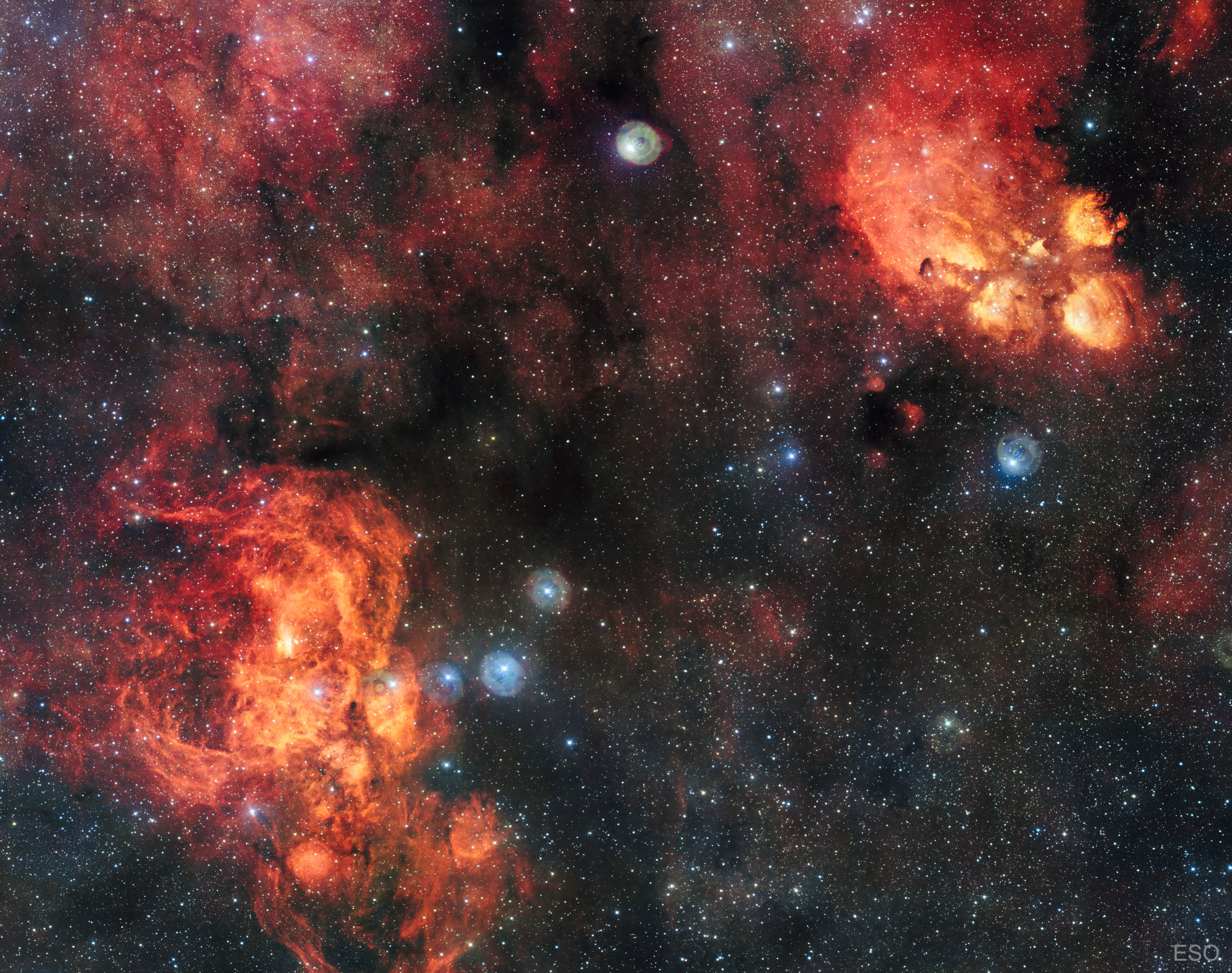
NGC 6357: The Lobster Nebula
Image Credit: ESO, VLT Survey Telescope
Explanation: Why is the Lobster Nebula forming some of the most massive stars known? No one is yet sure. Near the more obvious Cat's Paw nebula on the upper right, the Lobster Nebula, on the lower left and cataloged as NGC 6357, houses the open star cluster Pismis 24, home to these tremendously bright and blue stars. The overall red glow near the inner star forming region results from the emission of ionized hydrogen gas. The surrounding nebula, featured here, holds a complex tapestry of gas, dark dust, stars still forming, and newly born stars. The intricate patterns are caused by complex interactions between interstellar winds, radiation pressures, magnetic fields, and gravity. The full zoomable version of this image contains about two billion pixels, making it one of the largest space images ever released. NGC 6357 spans about 400 light years and lies about 8,000 light years away toward the constellation of the Scorpion.

NGC 6357: The Lobster Nebula
Image Credit: ESO, VLT Survey Telescope
Explanation: Why is the Lobster Nebula forming some of the most massive stars known? No one is yet sure. Near the more obvious Cat's Paw nebula on the upper right, the Lobster Nebula, on the lower left and cataloged as NGC 6357, houses the open star cluster Pismis 24, home to these tremendously bright and blue stars. The overall red glow near the inner star forming region results from the emission of ionized hydrogen gas. The surrounding nebula, featured here, holds a complex tapestry of gas, dark dust, stars still forming, and newly born stars. The intricate patterns are caused by complex interactions between interstellar winds, radiation pressures, magnetic fields, and gravity. The full zoomable version of this image contains about two billion pixels, making it one of the largest space images ever released. NGC 6357 spans about 400 light years and lies about 8,000 light years away toward the constellation of the Scorpion.

panosol- Αριθμός μηνυμάτων : 762
Points : 927
Reputation : 15
Ημερομηνία εγγραφής : 17/06/2012
Ηλικία : 56
 2017 February 8
2017 February 8
2017 February 8
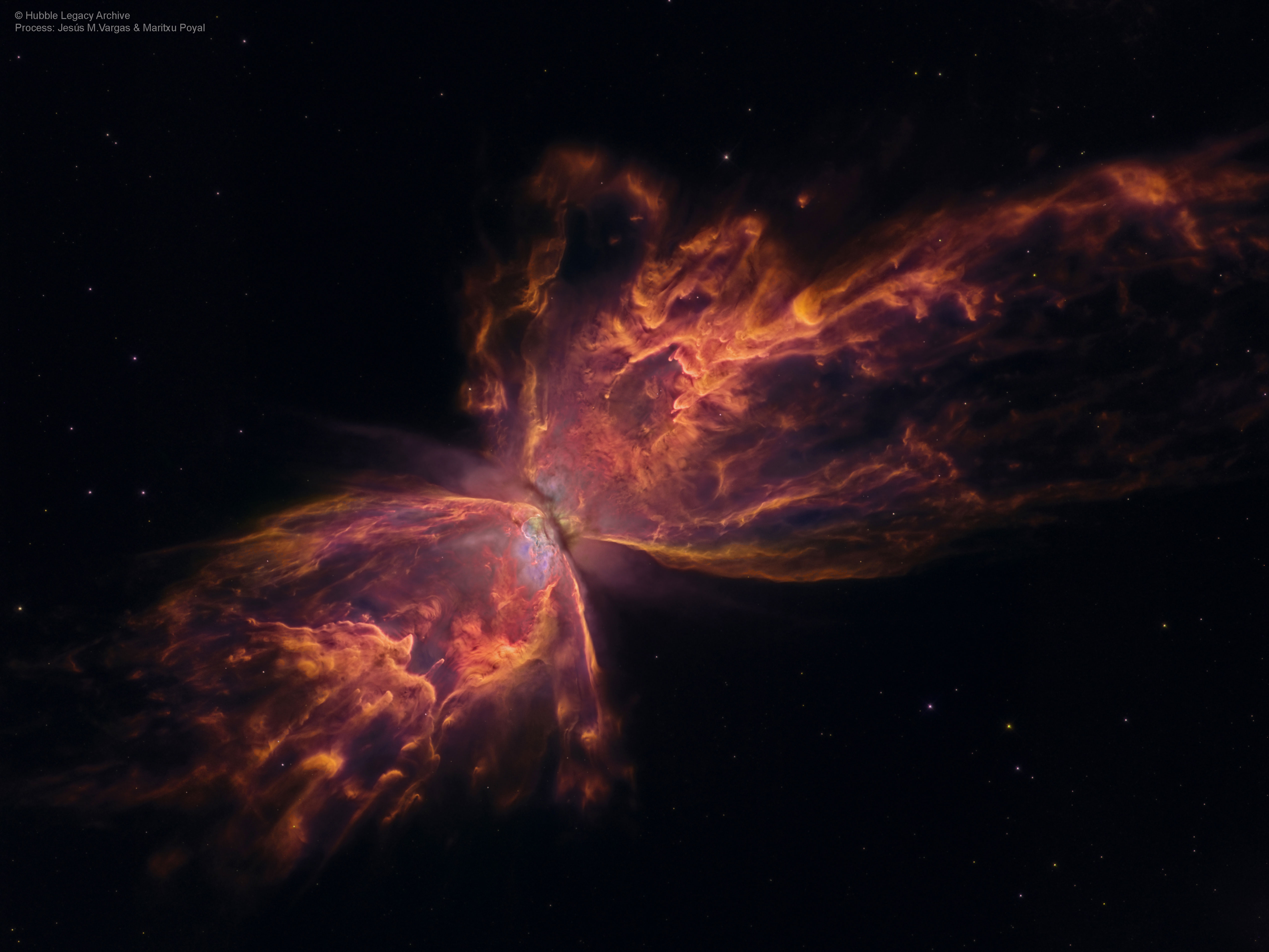
The Butterfly Nebula from Hubble
Image Credit: NASA, ESA, Hubble, HLA; Reprocessing & Copyright: Jesús M.Vargas & Maritxu Poyal
Explanation: The bright clusters and nebulae of planet Earth's night sky are often named for flowers or insects. Though its wingspan covers over 3 light-years, NGC 6302 is no exception. With an estimated surface temperature of about 250,000 degrees C, the dying central star of this particular planetary nebula has become exceptionally hot, shining brightly in ultraviolet light but hidden from direct view by a dense torus of dust. This sharp close-up of the dying star's nebula was recorded by the Hubble Space Telescope and is presented here in reprocessed colors. Cutting across a bright cavity of ionized gas, the dust torus surrounding the central star is near the center of this view, almost edge-on to the line-of-sight. Molecular hydrogen has been detected in the hot star's dusty cosmic shroud. NGC 6302 lies about 4,000 light-years away in the arachnologically correct constellation of the Scorpion (Scorpius).

The Butterfly Nebula from Hubble
Image Credit: NASA, ESA, Hubble, HLA; Reprocessing & Copyright: Jesús M.Vargas & Maritxu Poyal
Explanation: The bright clusters and nebulae of planet Earth's night sky are often named for flowers or insects. Though its wingspan covers over 3 light-years, NGC 6302 is no exception. With an estimated surface temperature of about 250,000 degrees C, the dying central star of this particular planetary nebula has become exceptionally hot, shining brightly in ultraviolet light but hidden from direct view by a dense torus of dust. This sharp close-up of the dying star's nebula was recorded by the Hubble Space Telescope and is presented here in reprocessed colors. Cutting across a bright cavity of ionized gas, the dust torus surrounding the central star is near the center of this view, almost edge-on to the line-of-sight. Molecular hydrogen has been detected in the hot star's dusty cosmic shroud. NGC 6302 lies about 4,000 light-years away in the arachnologically correct constellation of the Scorpion (Scorpius).

panosol- Αριθμός μηνυμάτων : 762
Points : 927
Reputation : 15
Ημερομηνία εγγραφής : 17/06/2012
Ηλικία : 56
 2017 February 9
2017 February 9
2017 February 9
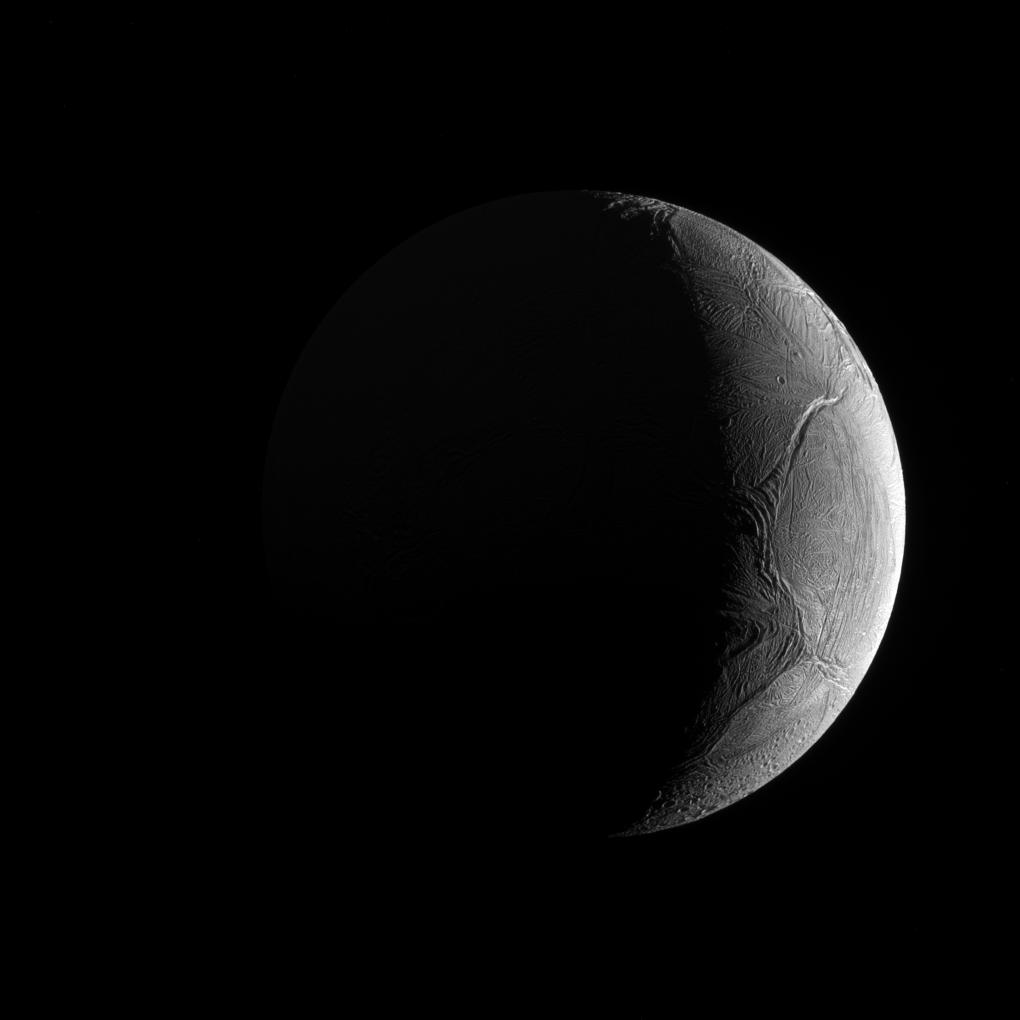
Crescent Enceladus
Image Credit: Cassini Imaging Team, SSI, JPL, ESA, NASA
Explanation: Peering from the shadows, the Saturn-facing hemisphere of tantalizing inner moon Enceladus poses in this Cassini spacecraft image. North is up in the dramatic scene captured last November as Cassini's camera was pointed in a nearly sunward direction about 130,000 kilometers from the moon's bright crescent. In fact, the distant world reflects over 90 percent of the sunlight it receives, giving its surface about the same reflectivity as fresh snow. A mere 500 kilometers in diameter, Enceladus is a surprisingly active moon. Data collected during Cassini's flybys and years of images have revealed the presence of remarkable south polar geysers and a possible global ocean of liquid water beneath an icy crust.

Crescent Enceladus
Image Credit: Cassini Imaging Team, SSI, JPL, ESA, NASA
Explanation: Peering from the shadows, the Saturn-facing hemisphere of tantalizing inner moon Enceladus poses in this Cassini spacecraft image. North is up in the dramatic scene captured last November as Cassini's camera was pointed in a nearly sunward direction about 130,000 kilometers from the moon's bright crescent. In fact, the distant world reflects over 90 percent of the sunlight it receives, giving its surface about the same reflectivity as fresh snow. A mere 500 kilometers in diameter, Enceladus is a surprisingly active moon. Data collected during Cassini's flybys and years of images have revealed the presence of remarkable south polar geysers and a possible global ocean of liquid water beneath an icy crust.

panosol- Αριθμός μηνυμάτων : 762
Points : 927
Reputation : 15
Ημερομηνία εγγραφής : 17/06/2012
Ηλικία : 56
 2017 February 10
2017 February 10
2017 February 10
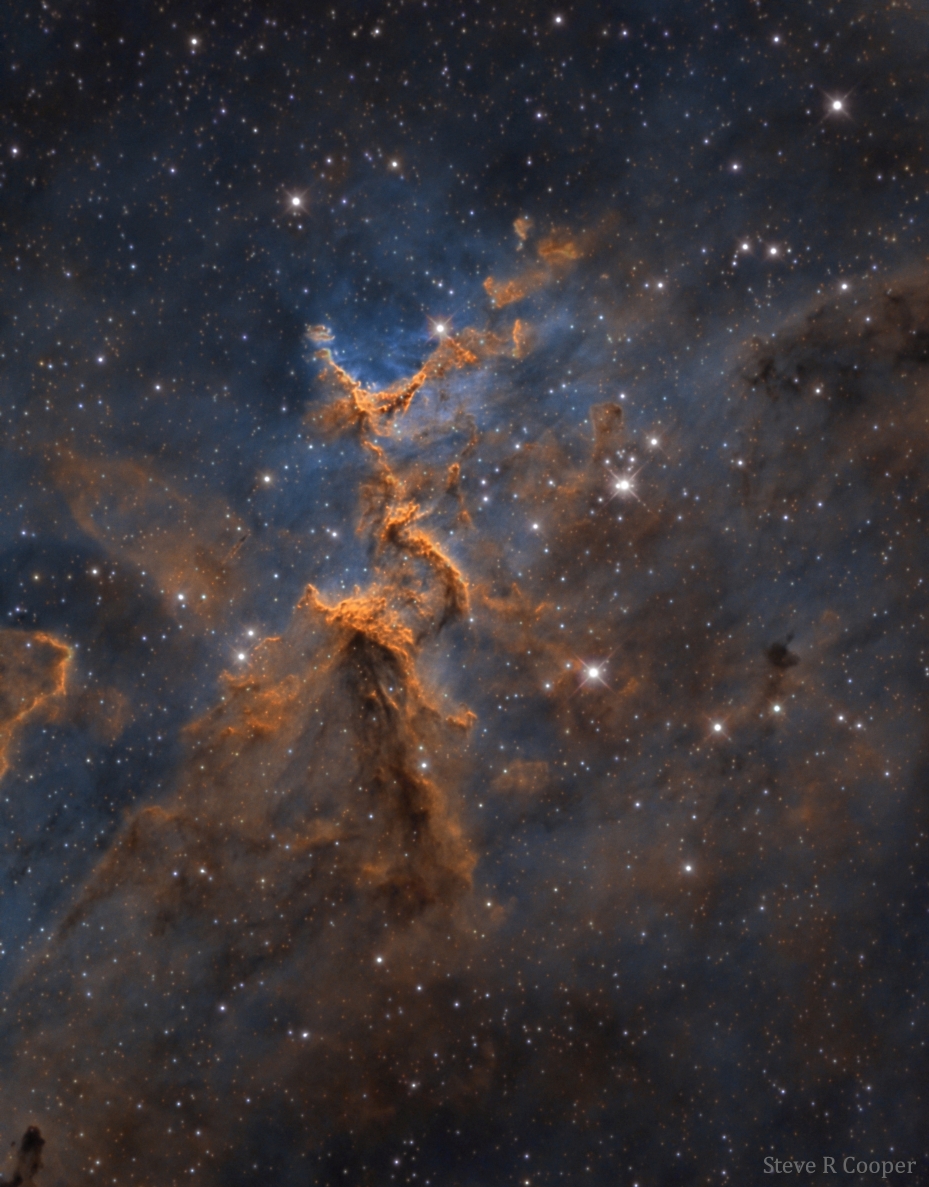
Melotte 15 in the Heart
Image Credit & Copyright: Steve Cooper
Explanation: Cosmic clouds form fantastic shapes in the central regions of emission nebula IC 1805. The clouds are sculpted by stellar winds and radiation from massive hot stars in the nebula's newborn star cluster, Melotte 15. About 1.5 million years young, the cluster stars are scattered in this colorful skyscape, along with dark dust clouds in silhouette against glowing atomic gas. A composite of narrowband and broadband telescopic images, the view spans about 15 light-years and includes emission from ionized hydrogen, sulfur, and oxygen atoms mapped to green, red, and blue hues in the popular Hubble Palette. Wider field images reveal that IC 1805's simpler, overall outline suggests its popular name - The Heart Nebula. IC 1805 is located about 7,500 light years away toward the boastful constellation Cassiopeia.

Melotte 15 in the Heart
Image Credit & Copyright: Steve Cooper
Explanation: Cosmic clouds form fantastic shapes in the central regions of emission nebula IC 1805. The clouds are sculpted by stellar winds and radiation from massive hot stars in the nebula's newborn star cluster, Melotte 15. About 1.5 million years young, the cluster stars are scattered in this colorful skyscape, along with dark dust clouds in silhouette against glowing atomic gas. A composite of narrowband and broadband telescopic images, the view spans about 15 light-years and includes emission from ionized hydrogen, sulfur, and oxygen atoms mapped to green, red, and blue hues in the popular Hubble Palette. Wider field images reveal that IC 1805's simpler, overall outline suggests its popular name - The Heart Nebula. IC 1805 is located about 7,500 light years away toward the boastful constellation Cassiopeia.

panosol- Αριθμός μηνυμάτων : 762
Points : 927
Reputation : 15
Ημερομηνία εγγραφής : 17/06/2012
Ηλικία : 56
 2017 February 11
2017 February 11
2017 February 11

Solar System Portrait
Image Credit: Voyager Project, NASA
Explanation: On Valentine's Day in 1990, cruising four billion miles from the Sun, the Voyager 1 spacecraft looked back one last time to make this first ever Solar System family portrait. The complete portrait is a 60 frame mosaic made from a vantage point 32 degrees above the ecliptic plane. In it, Voyager's wide angle camera frames sweep through the inner Solar System at the left, linking up with gas giant Neptune, the Solar System's outermost planet, at the far right. Positions for Venus, Earth, Jupiter, Saturn, Uranus, and Neptune are indicated by letters, while the Sun is the bright spot near the center of the circle of frames. The inset frames for each of the planets are from Voyager's narrow field camera. Unseen in the portrait are Mercury, too close to the Sun to be detected, and Mars, unfortunately hidden by sunlight scattered in the camera's optical system. Closer to the Sun than Neptune at the time, small, faint Pluto's position was not covered.

Solar System Portrait
Image Credit: Voyager Project, NASA
Explanation: On Valentine's Day in 1990, cruising four billion miles from the Sun, the Voyager 1 spacecraft looked back one last time to make this first ever Solar System family portrait. The complete portrait is a 60 frame mosaic made from a vantage point 32 degrees above the ecliptic plane. In it, Voyager's wide angle camera frames sweep through the inner Solar System at the left, linking up with gas giant Neptune, the Solar System's outermost planet, at the far right. Positions for Venus, Earth, Jupiter, Saturn, Uranus, and Neptune are indicated by letters, while the Sun is the bright spot near the center of the circle of frames. The inset frames for each of the planets are from Voyager's narrow field camera. Unseen in the portrait are Mercury, too close to the Sun to be detected, and Mars, unfortunately hidden by sunlight scattered in the camera's optical system. Closer to the Sun than Neptune at the time, small, faint Pluto's position was not covered.

panosol- Αριθμός μηνυμάτων : 762
Points : 927
Reputation : 15
Ημερομηνία εγγραφής : 17/06/2012
Ηλικία : 56
 2017 February 12
2017 February 12
2017 February 12
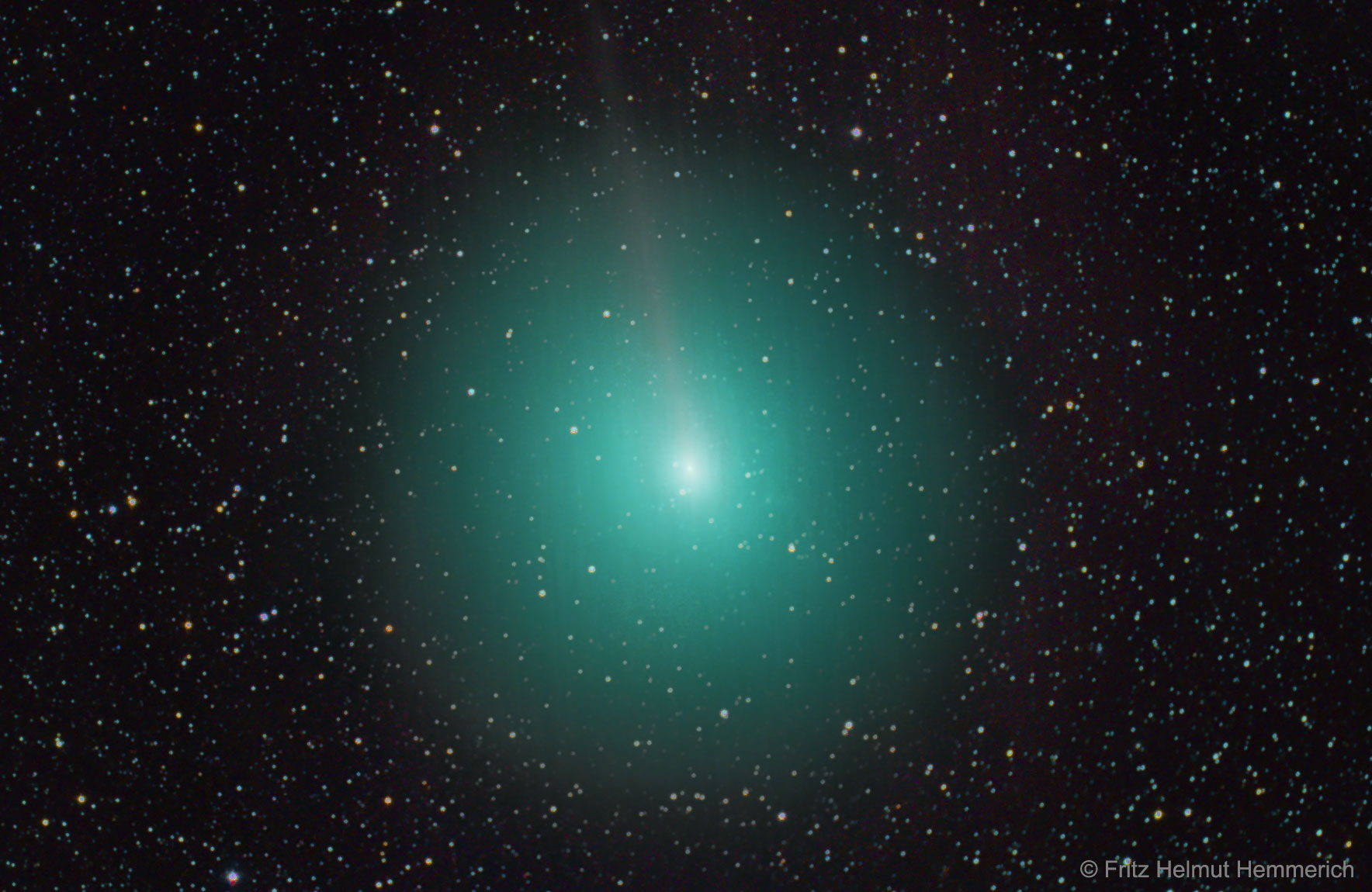
Comet 45P Passes Near the Earth
Image Credit & Copyright: Fritz Helmut Hemmerich
Explanation: A large snowball has just passed the Earth. Known as Comet 45P/Honda–Mrkos–Pajdušáková", or 45P for short, the comet came 10 times closer to Earth yesterday than the Earth ever gets to the Sun. During this passage, the comet was photographed sporting a thin ion tail and a faint but expansive green coma. The green color is caused mostly by energized molecules of carbon. Comet 45P became just bright enough to see with the unaided eye when it came closest to the Sun in December. Now, however, the comet is fading as it heads back out to near the orbit of Jupiter, where it spends most of its time. The kilometer-sized nucleus of ice and dirt will return to the inner Solar System in 2022.

Comet 45P Passes Near the Earth
Image Credit & Copyright: Fritz Helmut Hemmerich
Explanation: A large snowball has just passed the Earth. Known as Comet 45P/Honda–Mrkos–Pajdušáková", or 45P for short, the comet came 10 times closer to Earth yesterday than the Earth ever gets to the Sun. During this passage, the comet was photographed sporting a thin ion tail and a faint but expansive green coma. The green color is caused mostly by energized molecules of carbon. Comet 45P became just bright enough to see with the unaided eye when it came closest to the Sun in December. Now, however, the comet is fading as it heads back out to near the orbit of Jupiter, where it spends most of its time. The kilometer-sized nucleus of ice and dirt will return to the inner Solar System in 2022.

panosol- Αριθμός μηνυμάτων : 762
Points : 927
Reputation : 15
Ημερομηνία εγγραφής : 17/06/2012
Ηλικία : 56
 2017 February 13
2017 February 13
2017 February 13
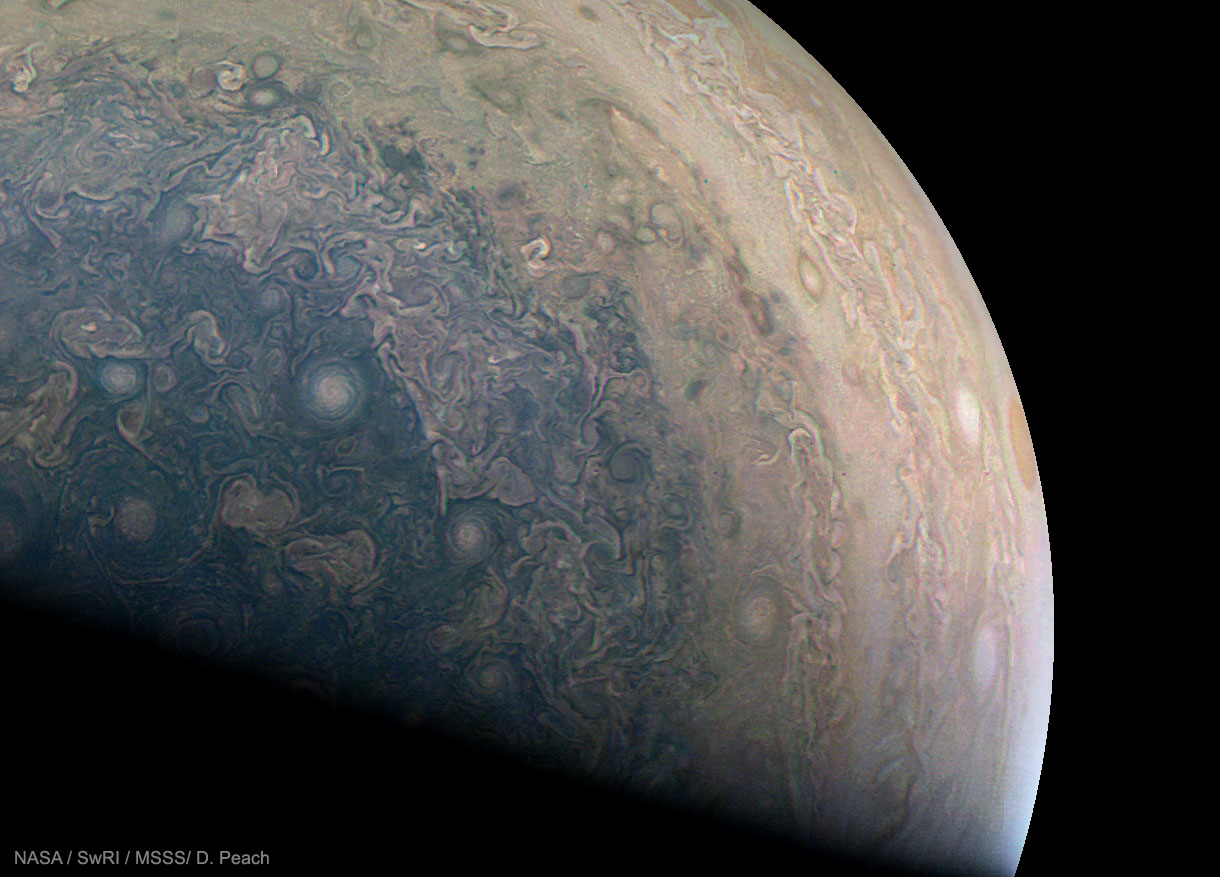
Cloud Swirls around Southern Jupiter from Juno
Image Credit: NASA, JPL-Caltech, SwRI, MSSS; Processing: Damian Peach
Explanation: Juno just completed its fourth pass near Jupiter. Launched from Earth in 2011 and arriving at Jupiter just last July, robotic Juno concluded its latest elliptical orbit around our Solar System's largest planet 11 days ago. Pictured here from that pass is a new high-resolution image of the southern hemisphere of Jupiter featuring a mesmerizing tapestry of swirling cloud systems. The terminator between day and night cuts diagonally across the bottom, meaning that the Sun is positioned off the top right. Large Oval BA is visible in orange on the far right. Reasons for the details and colors of Jupiter's cloud swirls are currently unknown. Juno planned six year mission will study Jovian giant in new ways, including trying to determine if beneath its thick clouds, Jupiter has a solid core.

Cloud Swirls around Southern Jupiter from Juno
Image Credit: NASA, JPL-Caltech, SwRI, MSSS; Processing: Damian Peach
Explanation: Juno just completed its fourth pass near Jupiter. Launched from Earth in 2011 and arriving at Jupiter just last July, robotic Juno concluded its latest elliptical orbit around our Solar System's largest planet 11 days ago. Pictured here from that pass is a new high-resolution image of the southern hemisphere of Jupiter featuring a mesmerizing tapestry of swirling cloud systems. The terminator between day and night cuts diagonally across the bottom, meaning that the Sun is positioned off the top right. Large Oval BA is visible in orange on the far right. Reasons for the details and colors of Jupiter's cloud swirls are currently unknown. Juno planned six year mission will study Jovian giant in new ways, including trying to determine if beneath its thick clouds, Jupiter has a solid core.

panosol- Αριθμός μηνυμάτων : 762
Points : 927
Reputation : 15
Ημερομηνία εγγραφής : 17/06/2012
Ηλικία : 56
 2017 February 14
2017 February 14
2017 February 14
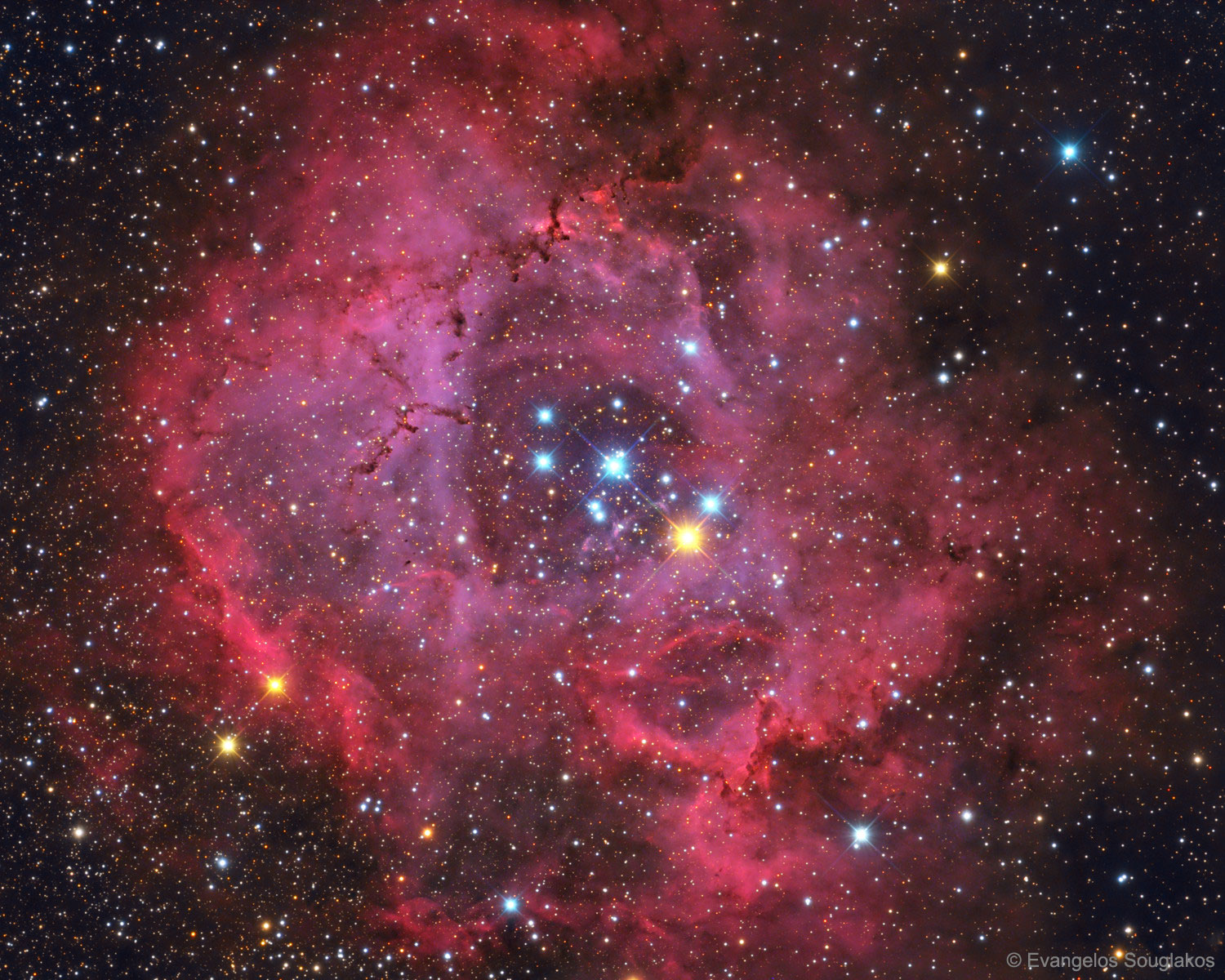
The Rosette Nebula
Image Credit & Copyright: Evangelos Souglakos
Explanation: Would the Rosette Nebula by any other name look as sweet? The bland New General Catalog designation of NGC 2237 doesn't appear to diminish the appearance of this flowery emission nebula. Inside the nebula lies an open cluster of bright young stars designated NGC 2244. These stars formed about four million years ago from the nebular material and their stellar winds are clearing a hole in the nebula's center, insulated by a layer of dust and hot gas. Ultraviolet light from the hot cluster stars causes the surrounding nebula to glow. The Rosette Nebula spans about 100 light-years across, lies about 5000 light-years away, and can be seen with a small telescope towards the constellation of the Unicorn (Monoceros).

The Rosette Nebula
Image Credit & Copyright: Evangelos Souglakos
Explanation: Would the Rosette Nebula by any other name look as sweet? The bland New General Catalog designation of NGC 2237 doesn't appear to diminish the appearance of this flowery emission nebula. Inside the nebula lies an open cluster of bright young stars designated NGC 2244. These stars formed about four million years ago from the nebular material and their stellar winds are clearing a hole in the nebula's center, insulated by a layer of dust and hot gas. Ultraviolet light from the hot cluster stars causes the surrounding nebula to glow. The Rosette Nebula spans about 100 light-years across, lies about 5000 light-years away, and can be seen with a small telescope towards the constellation of the Unicorn (Monoceros).

panosol- Αριθμός μηνυμάτων : 762
Points : 927
Reputation : 15
Ημερομηνία εγγραφής : 17/06/2012
Ηλικία : 56
 2017 February 15
2017 February 15
2017 February 15
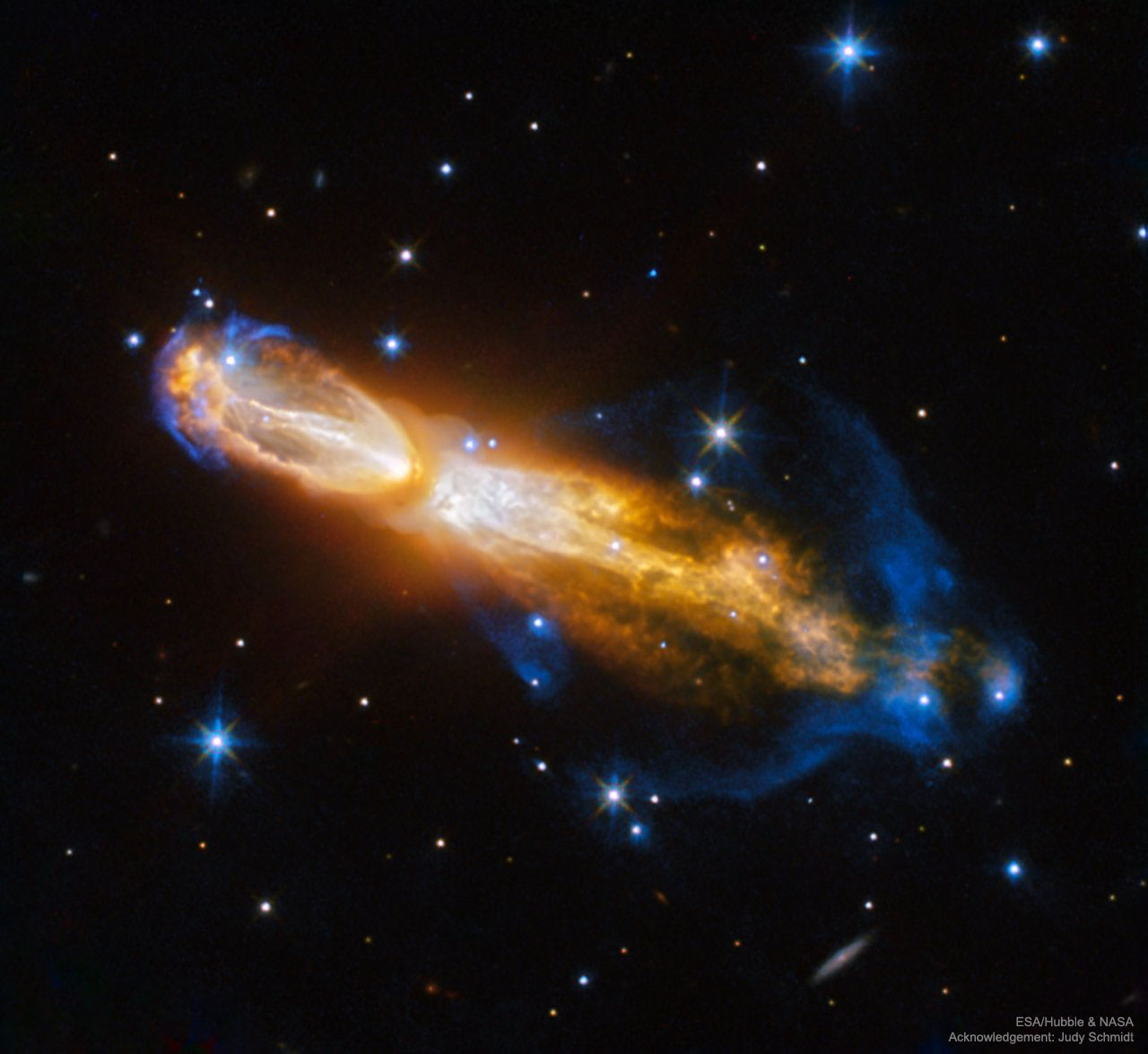
The Calabash Nebula from Hubble
Image Credit: NASA, ESA, Hubble, MAST; Acknowledgement: Judy Schmidt
Explanation: Fast expanding gas clouds mark the end for a central star in the Calabash Nebula. The once-normal star has run out of nuclear fuel, causing the central regions to contract into a white dwarf. Some of the liberated energy causes the outer envelope of the star to expand. In this case, the result is a photogenic proto-planetary nebula. As the million-kilometer per hour gas rams into the surrounding interstellar gas, a supersonic shock front forms where ionized hydrogen and nitrogen glow blue. Thick gas and dust hide the dying central star. The Calabash Nebula, also known as the Rotten Egg Nebula and OH231.8+4.2, will likely develop into a full bipolar planetary nebula over the next 1000 years. The nebula, featured here, is about 1.4 light-years in extent and located about 5000 light-years away toward the constellation of Puppis.

The Calabash Nebula from Hubble
Image Credit: NASA, ESA, Hubble, MAST; Acknowledgement: Judy Schmidt
Explanation: Fast expanding gas clouds mark the end for a central star in the Calabash Nebula. The once-normal star has run out of nuclear fuel, causing the central regions to contract into a white dwarf. Some of the liberated energy causes the outer envelope of the star to expand. In this case, the result is a photogenic proto-planetary nebula. As the million-kilometer per hour gas rams into the surrounding interstellar gas, a supersonic shock front forms where ionized hydrogen and nitrogen glow blue. Thick gas and dust hide the dying central star. The Calabash Nebula, also known as the Rotten Egg Nebula and OH231.8+4.2, will likely develop into a full bipolar planetary nebula over the next 1000 years. The nebula, featured here, is about 1.4 light-years in extent and located about 5000 light-years away toward the constellation of Puppis.

panosol- Αριθμός μηνυμάτων : 762
Points : 927
Reputation : 15
Ημερομηνία εγγραφής : 17/06/2012
Ηλικία : 56
 2017 February 16
2017 February 16
2017 February 16

The Tulip and Cygnus X-1
Image Credit & Copyright: Ivan Eder
Explanation: Framing a bright emission region, this telescopic view looks out along the plane of our Milky Way Galaxy toward the nebula rich constellation Cygnus the Swan. Popularly called the Tulip Nebula, the reddish glowing cloud of interstellar gas and dust is also found in the 1959 catalog by astronomer Stewart Sharpless as Sh2-101. About 8,000 light-years distant and 70 light-years across the complex and beautiful nebula blossoms at the center of this composite image. Ultraviolet radiation from young energetic stars at the edge of the Cygnus OB3 association, including O star HDE 227018, ionizes the atoms and powers the emission from the Tulip Nebula. HDE 227018 is the bright star near the center of the nebula. Also framed in the field of view is microquasar Cygnus X-1, one of the strongest X-ray sources in planet Earth's sky. Driven by powerful jets from a black hole accretion disk, its fainter visible curved shock front lies above and right, just beyond the cosmic Tulip's petals.

The Tulip and Cygnus X-1
Image Credit & Copyright: Ivan Eder
Explanation: Framing a bright emission region, this telescopic view looks out along the plane of our Milky Way Galaxy toward the nebula rich constellation Cygnus the Swan. Popularly called the Tulip Nebula, the reddish glowing cloud of interstellar gas and dust is also found in the 1959 catalog by astronomer Stewart Sharpless as Sh2-101. About 8,000 light-years distant and 70 light-years across the complex and beautiful nebula blossoms at the center of this composite image. Ultraviolet radiation from young energetic stars at the edge of the Cygnus OB3 association, including O star HDE 227018, ionizes the atoms and powers the emission from the Tulip Nebula. HDE 227018 is the bright star near the center of the nebula. Also framed in the field of view is microquasar Cygnus X-1, one of the strongest X-ray sources in planet Earth's sky. Driven by powerful jets from a black hole accretion disk, its fainter visible curved shock front lies above and right, just beyond the cosmic Tulip's petals.

panosol- Αριθμός μηνυμάτων : 762
Points : 927
Reputation : 15
Ημερομηνία εγγραφής : 17/06/2012
Ηλικία : 56
 2017 February 17
2017 February 17
2017 February 17
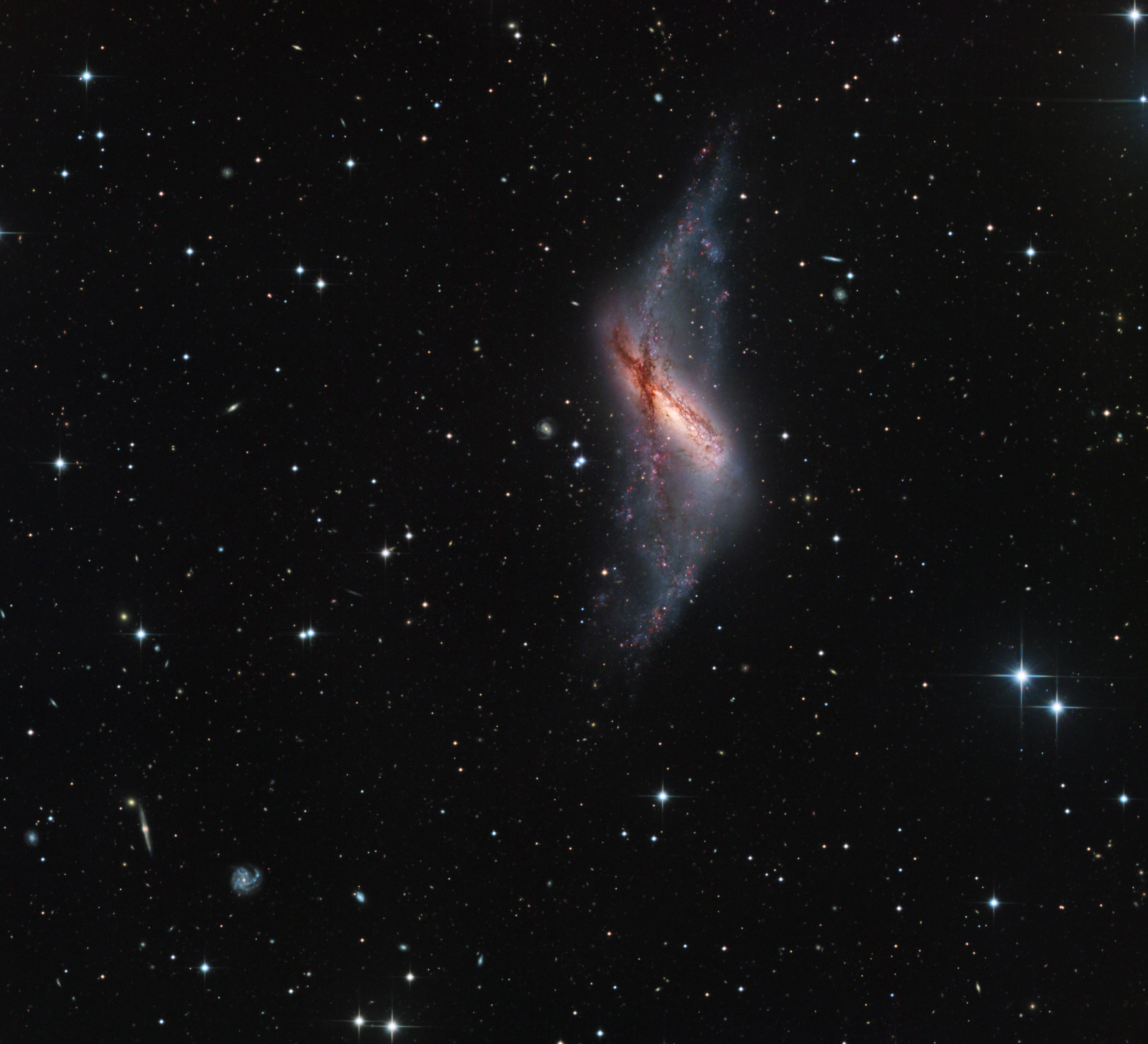
Polar Ring Galaxy NGC 660
Image Credit & Copyright: CHART32 Team, Processing - Johannes Schedler
Explanation: NGC 660 is featured in this cosmic snapshot. Over 40 million light-years away and swimming within the boundaries of the constellation Pisces, NGC 660's peculiar appearance marks it as a polar ring galaxy. A rare galaxy type, polar ring galaxies have a substantial population of stars, gas, and dust orbiting in rings strongly tilted from the plane of the galactic disk. The bizarre-looking configuration could have been caused by the chance capture of material from a passing galaxy by a disk galaxy, with the captured debris eventually strung out in a rotating ring. The violent gravitational interaction would account for the myriad pinkish star forming regions scattered along NGC 660's ring. The polar ring component can also be used to explore the shape of the galaxy's otherwise unseen dark matter halo by calculating the dark matter's gravitational influence on the rotation of the ring and disk. Broader than the disk, NGC 660's ring spans over 50,000 light-years.

Polar Ring Galaxy NGC 660
Image Credit & Copyright: CHART32 Team, Processing - Johannes Schedler
Explanation: NGC 660 is featured in this cosmic snapshot. Over 40 million light-years away and swimming within the boundaries of the constellation Pisces, NGC 660's peculiar appearance marks it as a polar ring galaxy. A rare galaxy type, polar ring galaxies have a substantial population of stars, gas, and dust orbiting in rings strongly tilted from the plane of the galactic disk. The bizarre-looking configuration could have been caused by the chance capture of material from a passing galaxy by a disk galaxy, with the captured debris eventually strung out in a rotating ring. The violent gravitational interaction would account for the myriad pinkish star forming regions scattered along NGC 660's ring. The polar ring component can also be used to explore the shape of the galaxy's otherwise unseen dark matter halo by calculating the dark matter's gravitational influence on the rotation of the ring and disk. Broader than the disk, NGC 660's ring spans over 50,000 light-years.

panosol- Αριθμός μηνυμάτων : 762
Points : 927
Reputation : 15
Ημερομηνία εγγραφής : 17/06/2012
Ηλικία : 56
 2017 February 18
2017 February 18
2017 February 18
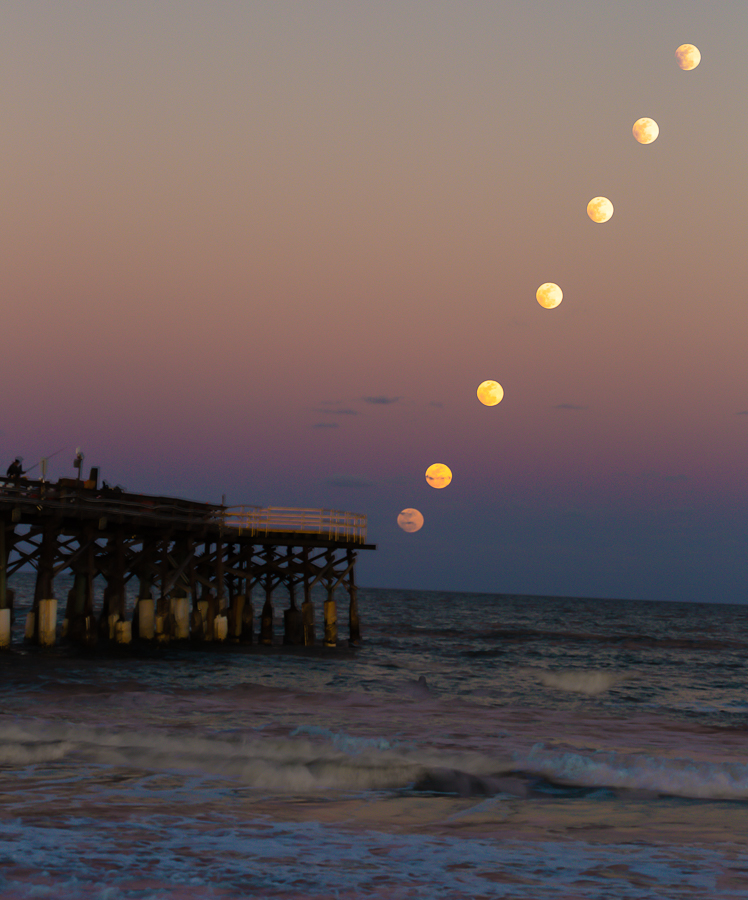
Penumbral Eclipse Rising
Image Credit & Copyright: Bill Jelen
Explanation: As seen from Cocoa Beach Pier, Florida, planet Earth, the Moon rose at sunset on February 10 while gliding through Earth's faint outer shadow. In progress was the first eclipse of 2017, a penumbral lunar eclipse followed in this digital stack of seaside exposures. Of course, the penumbral shadow is lighter than the planet's umbral shadow. That central, dark, shadow is easily seen on the lunar disk during a total or partial lunar eclipse. Still, in this penumbral eclipse the limb of the Moon grows just perceptibly darker as it rises above the western horizon. The second eclipse of 2017 could be more dramatic though. With viewing from a path across planet Earth's southern hemisphere, on February 26 there will be an annular eclipse of the Sun.

Penumbral Eclipse Rising
Image Credit & Copyright: Bill Jelen
Explanation: As seen from Cocoa Beach Pier, Florida, planet Earth, the Moon rose at sunset on February 10 while gliding through Earth's faint outer shadow. In progress was the first eclipse of 2017, a penumbral lunar eclipse followed in this digital stack of seaside exposures. Of course, the penumbral shadow is lighter than the planet's umbral shadow. That central, dark, shadow is easily seen on the lunar disk during a total or partial lunar eclipse. Still, in this penumbral eclipse the limb of the Moon grows just perceptibly darker as it rises above the western horizon. The second eclipse of 2017 could be more dramatic though. With viewing from a path across planet Earth's southern hemisphere, on February 26 there will be an annular eclipse of the Sun.

panosol- Αριθμός μηνυμάτων : 762
Points : 927
Reputation : 15
Ημερομηνία εγγραφής : 17/06/2012
Ηλικία : 56
 2017 February 19
2017 February 19
2017 February 19
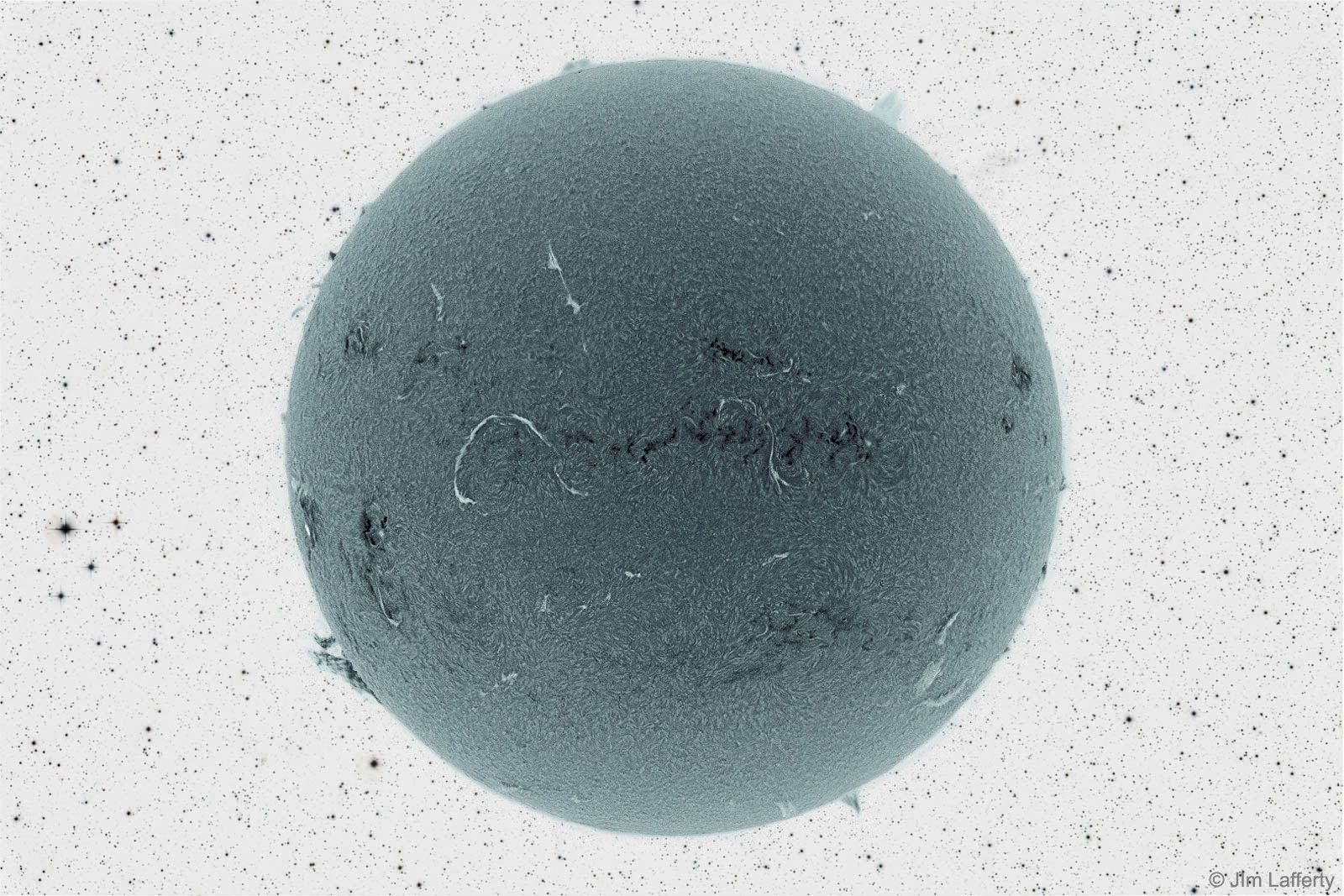
Black Sun and Inverted Starfield
Image Credit & Copyright: Jim Lafferty
Explanation: Does this strange dark ball look somehow familiar? If so, that might be because it is our Sun. In the featured image from 2012, a detailed solar view was captured originally in a very specific color of red light, then rendered in black and white, and then color inverted. Once complete, the resulting image was added to a starfield, then also color inverted. Visible in the image of the Sun are long light filaments, dark active regions, prominences peeking around the edge, and a moving carpet of hot gas. The surface of our Sun can be a busy place, in particular during Solar Maximum, the time when its surface magnetic field is wound up the most. Besides an active Sun being so picturesque, the plasma expelled can also become picturesque when it impacts the Earth's magnetosphere and creates auroras.

Black Sun and Inverted Starfield
Image Credit & Copyright: Jim Lafferty
Explanation: Does this strange dark ball look somehow familiar? If so, that might be because it is our Sun. In the featured image from 2012, a detailed solar view was captured originally in a very specific color of red light, then rendered in black and white, and then color inverted. Once complete, the resulting image was added to a starfield, then also color inverted. Visible in the image of the Sun are long light filaments, dark active regions, prominences peeking around the edge, and a moving carpet of hot gas. The surface of our Sun can be a busy place, in particular during Solar Maximum, the time when its surface magnetic field is wound up the most. Besides an active Sun being so picturesque, the plasma expelled can also become picturesque when it impacts the Earth's magnetosphere and creates auroras.

panosol- Αριθμός μηνυμάτων : 762
Points : 927
Reputation : 15
Ημερομηνία εγγραφής : 17/06/2012
Ηλικία : 56
 2017 February 20
2017 February 20
2017 February 20
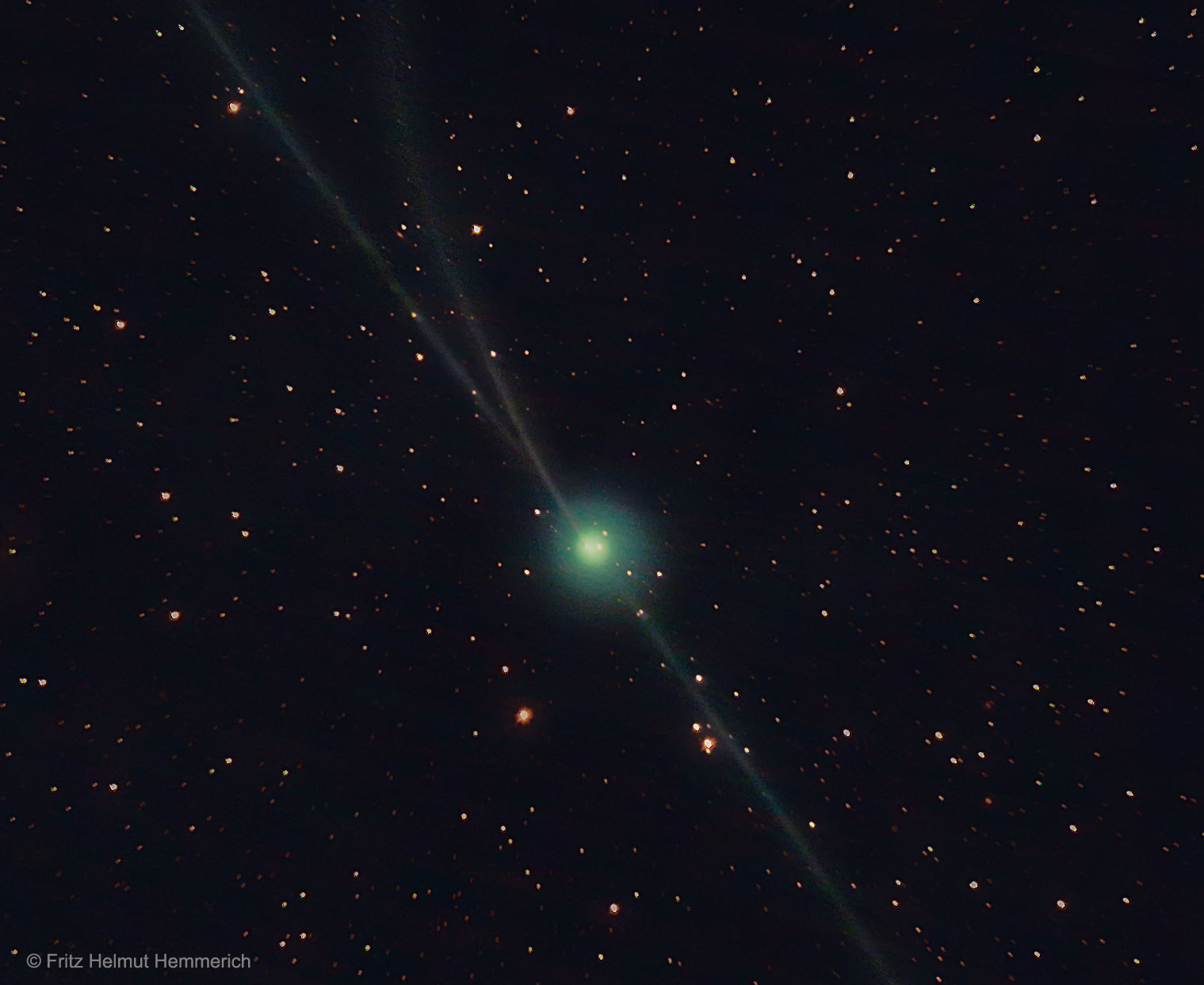
Almost Three Tails for Comet Encke
Image Credit & Copyright: Fritz Helmut Hemmerich
Explanation: How can a comet have three tails? Normally, a comet has two tails: an ion tail of charged particles emitted by the comet and pushed out by the wind from the Sun, and a dust tail of small debris that orbits behind the comet but is also pushed out, to some degree, by the solar wind. Frequently a comet will appear to have only one tail because the other tail is not easily visible from the Earth. In the featured unusual image, Comet 2P/Encke appears to have three tails because the ion tail split just near to the time when the image was taken. The complex solar wind is occasionally turbulent and sometimes creates unusual structure in an ion tail. On rare occasions even ion-tail disconnection events have been recorded. An image of the Comet Encke taken two days later gives a perhaps less perplexing perspective.

Almost Three Tails for Comet Encke
Image Credit & Copyright: Fritz Helmut Hemmerich
Explanation: How can a comet have three tails? Normally, a comet has two tails: an ion tail of charged particles emitted by the comet and pushed out by the wind from the Sun, and a dust tail of small debris that orbits behind the comet but is also pushed out, to some degree, by the solar wind. Frequently a comet will appear to have only one tail because the other tail is not easily visible from the Earth. In the featured unusual image, Comet 2P/Encke appears to have three tails because the ion tail split just near to the time when the image was taken. The complex solar wind is occasionally turbulent and sometimes creates unusual structure in an ion tail. On rare occasions even ion-tail disconnection events have been recorded. An image of the Comet Encke taken two days later gives a perhaps less perplexing perspective.

panosol- Αριθμός μηνυμάτων : 762
Points : 927
Reputation : 15
Ημερομηνία εγγραφής : 17/06/2012
Ηλικία : 56
 2017 February 21
2017 February 21
2017 February 21
An Active Night over the Magellan Telescopes
Image Credit & Copyright: Yuri Beletsky (Carnegie Las Campanas Observatory, TWAN);
Music Credit & License: Airglow by Club 220
Explanation: The night sky is always changing. Featured here are changes that occurred over a six hour period in late 2014 June behind the dual 6.5-meter Magellan Telescopes at Las Campanas Observatory in Chile. The initial red glow on the horizon is airglow, a slight cooling of high air by the emission of specific colors of light. Bands of airglow are also visible throughout the time-lapse video. Early in the night, car headlights flash on the far left. Satellites quickly shoot past as they circle the Earth and reflect sunlight. A long and thin cloud passes slowly overhead. The Large Magellanic Cloud rises on the left, while the expansive central band of our Milky Way Galaxy arches and pivots as the Earth rotates. As the night progresses, the Magellan telescopes swivel and stare as they explore pre-determined patches of the night sky. Every night, every sky changes differently, even though the phenomena at play are usually the same.
An Active Night over the Magellan Telescopes
Image Credit & Copyright: Yuri Beletsky (Carnegie Las Campanas Observatory, TWAN);
Music Credit & License: Airglow by Club 220
Explanation: The night sky is always changing. Featured here are changes that occurred over a six hour period in late 2014 June behind the dual 6.5-meter Magellan Telescopes at Las Campanas Observatory in Chile. The initial red glow on the horizon is airglow, a slight cooling of high air by the emission of specific colors of light. Bands of airglow are also visible throughout the time-lapse video. Early in the night, car headlights flash on the far left. Satellites quickly shoot past as they circle the Earth and reflect sunlight. A long and thin cloud passes slowly overhead. The Large Magellanic Cloud rises on the left, while the expansive central band of our Milky Way Galaxy arches and pivots as the Earth rotates. As the night progresses, the Magellan telescopes swivel and stare as they explore pre-determined patches of the night sky. Every night, every sky changes differently, even though the phenomena at play are usually the same.

panosol- Αριθμός μηνυμάτων : 762
Points : 927
Reputation : 15
Ημερομηνία εγγραφής : 17/06/2012
Ηλικία : 56
 2017 February 22
2017 February 22
2017 February 22

Daphnis and the Rings of Saturn
Image Credit: NASA, JPL-Caltech, Space Science Institute, Cassini
Explanation: What's happening to the rings of Saturn? Nothing much, just a little moon making waves. The moon is 8-kilometer Daphnis and it is making waves in the Keeler Gap of Saturn's rings using just its gravity -- as it bobs up and down, in and out. The featured image is a wide-field version of a previously released image taken last month by the robotic Cassini spacecraft during one of its new Grand Finale orbits. Daphnis can be seen on the far right, sporting ridges likely accumulated from ring particles. Daphnis was discovered in Cassini images in 2005 and raised mounds of ring particles so high in 2009 -- during Saturn's equinox when the ring plane pointed directly at the Sun -- that they cast notable shadows.

Daphnis and the Rings of Saturn
Image Credit: NASA, JPL-Caltech, Space Science Institute, Cassini
Explanation: What's happening to the rings of Saturn? Nothing much, just a little moon making waves. The moon is 8-kilometer Daphnis and it is making waves in the Keeler Gap of Saturn's rings using just its gravity -- as it bobs up and down, in and out. The featured image is a wide-field version of a previously released image taken last month by the robotic Cassini spacecraft during one of its new Grand Finale orbits. Daphnis can be seen on the far right, sporting ridges likely accumulated from ring particles. Daphnis was discovered in Cassini images in 2005 and raised mounds of ring particles so high in 2009 -- during Saturn's equinox when the ring plane pointed directly at the Sun -- that they cast notable shadows.

panosol- Αριθμός μηνυμάτων : 762
Points : 927
Reputation : 15
Ημερομηνία εγγραφής : 17/06/2012
Ηλικία : 56
 2017 February 23
2017 February 23
2017 February 23
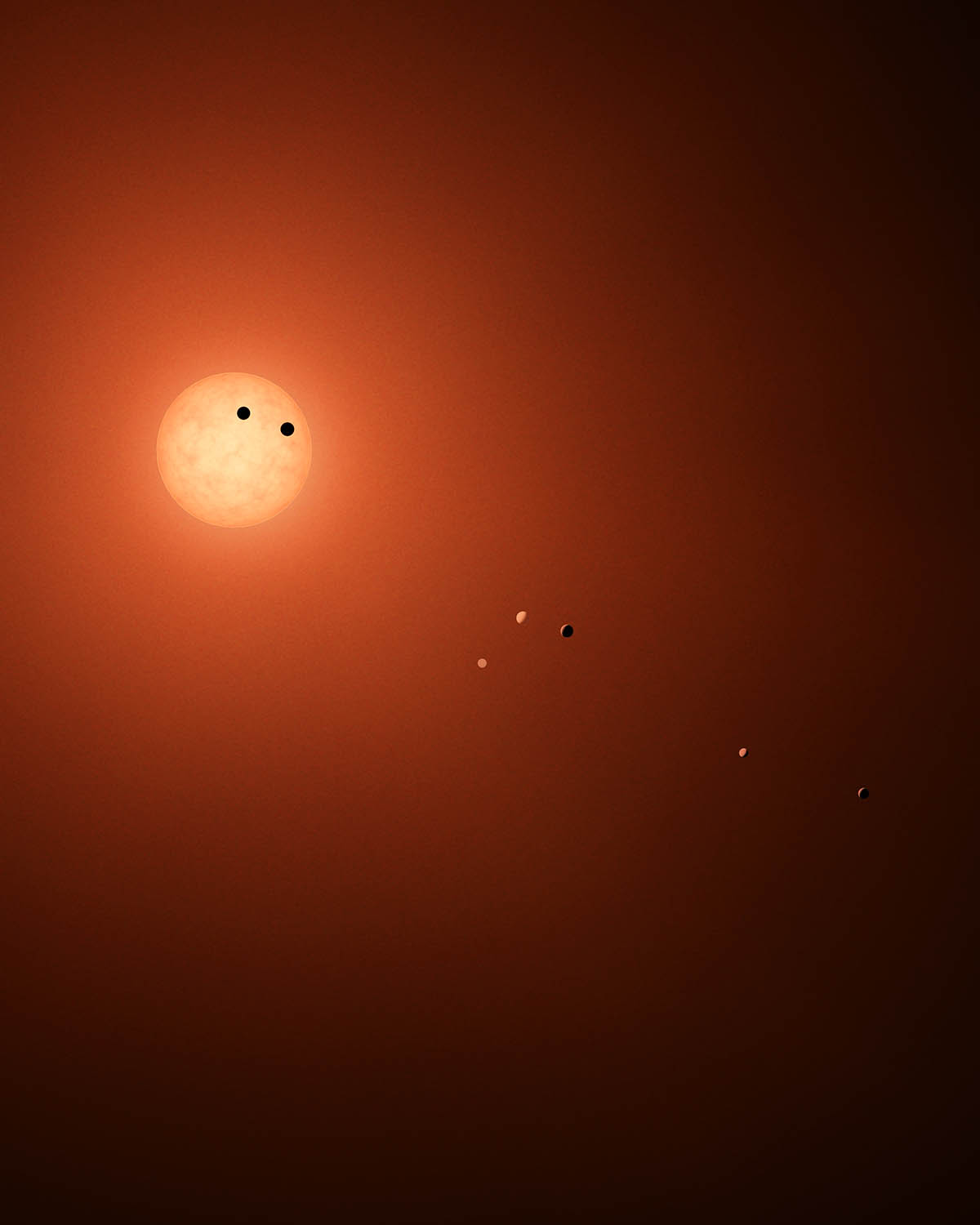
Seven Worlds for TRAPPIST-1
Illustration Credit: NASA, JPL-Caltech, Spitzer Space Telescope, Robert Hurt (Spitzer, Caltech)
Explanation: Seven worlds orbit the ultracool dwarf star TRAPPIST-1, a mere 40 light-years away. In May 2016 astronomers using the Transiting Planets and Planetesimals Small Telescope (TRAPPIST) announced the discovery of three planets in the TRAPPIST-1 system. Just announced, additional confirmations and discoveries by the Spitzer Space Telescope and supporting ESO ground-based telescopes have increased the number of known planets to seven. The TRAPPIST-1 planets are likely all rocky and similar in size to Earth, the largest treasure trove of terrestrial planets ever detected around a single star. Because they orbit very close to their faint, tiny star they could also have regions where surface temperatures allow for the presence of liquid water, a key ingredient for life. Their tantalizing proximity to Earth makes them prime candidates for future telescopic explorations of the atmospheres of potentially habitable planets. All seven worlds appear in this artist's illustration, an imagined view from a fictionally powerful telescope near planet Earth. Planet sizes and relative positions are drawn to scale for the Spitzer observations. The system's inner planets are transiting their dim, red, nearly Jupiter-sized parent star.

Seven Worlds for TRAPPIST-1
Illustration Credit: NASA, JPL-Caltech, Spitzer Space Telescope, Robert Hurt (Spitzer, Caltech)
Explanation: Seven worlds orbit the ultracool dwarf star TRAPPIST-1, a mere 40 light-years away. In May 2016 astronomers using the Transiting Planets and Planetesimals Small Telescope (TRAPPIST) announced the discovery of three planets in the TRAPPIST-1 system. Just announced, additional confirmations and discoveries by the Spitzer Space Telescope and supporting ESO ground-based telescopes have increased the number of known planets to seven. The TRAPPIST-1 planets are likely all rocky and similar in size to Earth, the largest treasure trove of terrestrial planets ever detected around a single star. Because they orbit very close to their faint, tiny star they could also have regions where surface temperatures allow for the presence of liquid water, a key ingredient for life. Their tantalizing proximity to Earth makes them prime candidates for future telescopic explorations of the atmospheres of potentially habitable planets. All seven worlds appear in this artist's illustration, an imagined view from a fictionally powerful telescope near planet Earth. Planet sizes and relative positions are drawn to scale for the Spitzer observations. The system's inner planets are transiting their dim, red, nearly Jupiter-sized parent star.

panosol- Αριθμός μηνυμάτων : 762
Points : 927
Reputation : 15
Ημερομηνία εγγραφής : 17/06/2012
Ηλικία : 56
 2017 February 24
2017 February 24
2017 February 24
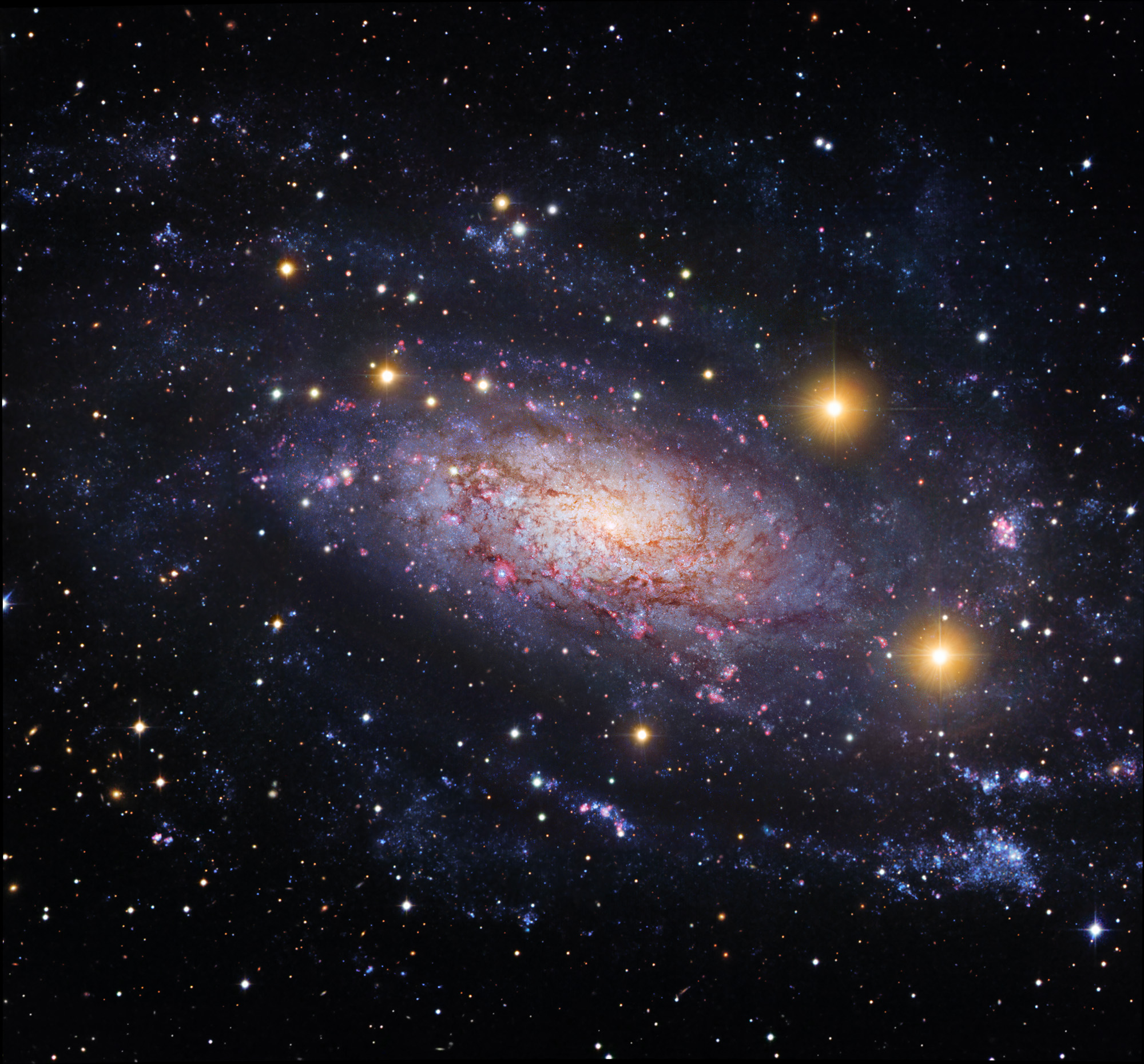
NGC 3621: Far Beyond the Local Group
Image Credit & Copyright: Processing - Robert Gendler, Roberto Colombari
Data - Hubble Legacy Archive, European Southern Observatory, et al.
Explanation: Far beyond the local group of galaxies lies NGC 3621, some 22 million light-years away. Found in the multi-headed southern constellation Hydra, the winding spiral arms of this gorgeous island universe are loaded with luminous blue star clusters, pinkish starforming regions, and dark dust lanes. Still, for astronomers NGC 3621 has not been just another pretty face-on spiral galaxy. Some of its brighter stars have been used as standard candles to establish important estimates of extragalactic distances and the scale of the Universe. This beautiful image of NGC 3621, is a composite of space- and ground-based telescope data. It traces the loose spiral arms far from the galaxy's brighter central regions for some 100,000 light-years. Spiky foreground stars in our own Milky Way Galaxy and even more distant background galaxies are scattered across the colorful skyscape.

NGC 3621: Far Beyond the Local Group
Image Credit & Copyright: Processing - Robert Gendler, Roberto Colombari
Data - Hubble Legacy Archive, European Southern Observatory, et al.
Explanation: Far beyond the local group of galaxies lies NGC 3621, some 22 million light-years away. Found in the multi-headed southern constellation Hydra, the winding spiral arms of this gorgeous island universe are loaded with luminous blue star clusters, pinkish starforming regions, and dark dust lanes. Still, for astronomers NGC 3621 has not been just another pretty face-on spiral galaxy. Some of its brighter stars have been used as standard candles to establish important estimates of extragalactic distances and the scale of the Universe. This beautiful image of NGC 3621, is a composite of space- and ground-based telescope data. It traces the loose spiral arms far from the galaxy's brighter central regions for some 100,000 light-years. Spiky foreground stars in our own Milky Way Galaxy and even more distant background galaxies are scattered across the colorful skyscape.

panosol- Αριθμός μηνυμάτων : 762
Points : 927
Reputation : 15
Ημερομηνία εγγραφής : 17/06/2012
Ηλικία : 56
 2017 February 25
2017 February 25
2017 February 25

All Planets Panorama
Image Credit & Copyright: Tunç Tezel (TWAN)
Explanation: For 360 degrees, a view along the plane of the ecliptic is captured in this remarkable panorama, with seven planets in a starry sky. The mosaic was constructed using images taken during January 24-26, from Nacpan Beach, El Nido in Palawan, Philippines. It covers the eastern horizon (left) in dark early morning hours and the western horizon in evening skies. While the ecliptic runs along the middle traced by a faint band of zodiacal light, the Milky Way also cuts at angles through the frame. Clouds and the Moon join fleeting planet Mercury in the east. Yellowish Saturn, bright star Antares, and Jupiter lie near the ecliptic farther right. Hugging the ecliptic near center are Leo's alpha star Regulus and star cluster M44. The evening planets gathered along the ecliptic above the western horizon, are faint Uranus, ruddy Mars, brilliant Venus, and even fainter Neptune. A well labeled version of the panorama can be viewed by sliding your cursor over the picture, or just following this link.

All Planets Panorama
Image Credit & Copyright: Tunç Tezel (TWAN)
Explanation: For 360 degrees, a view along the plane of the ecliptic is captured in this remarkable panorama, with seven planets in a starry sky. The mosaic was constructed using images taken during January 24-26, from Nacpan Beach, El Nido in Palawan, Philippines. It covers the eastern horizon (left) in dark early morning hours and the western horizon in evening skies. While the ecliptic runs along the middle traced by a faint band of zodiacal light, the Milky Way also cuts at angles through the frame. Clouds and the Moon join fleeting planet Mercury in the east. Yellowish Saturn, bright star Antares, and Jupiter lie near the ecliptic farther right. Hugging the ecliptic near center are Leo's alpha star Regulus and star cluster M44. The evening planets gathered along the ecliptic above the western horizon, are faint Uranus, ruddy Mars, brilliant Venus, and even fainter Neptune. A well labeled version of the panorama can be viewed by sliding your cursor over the picture, or just following this link.

panosol- Αριθμός μηνυμάτων : 762
Points : 927
Reputation : 15
Ημερομηνία εγγραφής : 17/06/2012
Ηλικία : 56
 2017 February 26
2017 February 26
2017 February 26
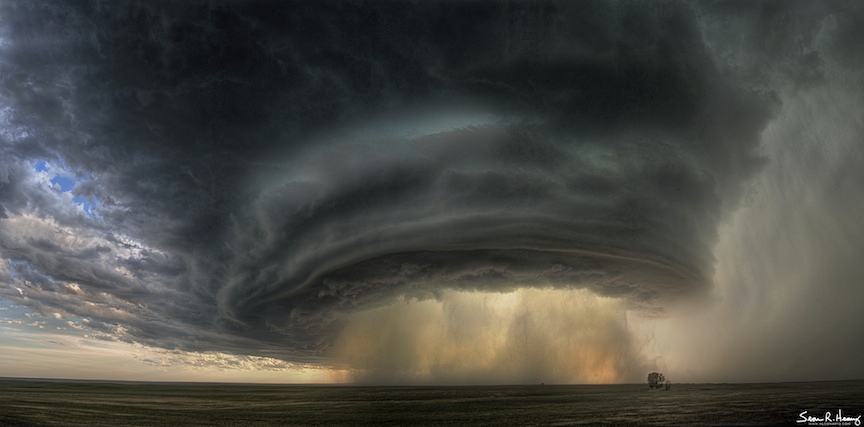
A Supercell Thunderstorm Cloud Over Montana
Image Credit & Copyright: Sean R. Heavey
Explanation: Is that a spaceship or a cloud? Although it may seem like an alien mothership, it's actually a impressive thunderstorm cloud called a supercell. Such colossal storm systems center on mesocyclones -- rotating updrafts that can span several kilometers and deliver torrential rain and high winds including tornadoes. Jagged sculptured clouds adorn the supercell's edge, while wind swept dust and rain dominate the center. A tree waits patiently in the foreground. The above supercell cloud was photographed in 2010 July west of Glasgow, Montana, USA, caused minor damage, and lasted several hours before moving on.

A Supercell Thunderstorm Cloud Over Montana
Image Credit & Copyright: Sean R. Heavey
Explanation: Is that a spaceship or a cloud? Although it may seem like an alien mothership, it's actually a impressive thunderstorm cloud called a supercell. Such colossal storm systems center on mesocyclones -- rotating updrafts that can span several kilometers and deliver torrential rain and high winds including tornadoes. Jagged sculptured clouds adorn the supercell's edge, while wind swept dust and rain dominate the center. A tree waits patiently in the foreground. The above supercell cloud was photographed in 2010 July west of Glasgow, Montana, USA, caused minor damage, and lasted several hours before moving on.

panosol- Αριθμός μηνυμάτων : 762
Points : 927
Reputation : 15
Ημερομηνία εγγραφής : 17/06/2012
Ηλικία : 56
 2017 February 27
2017 February 27
2017 February 27

Four Quasar Images Surround a Galaxy Lens
Image Credit: ESA/Hubble, NASA, Sherry Suyu et al.
Explanation: An odd thing about the group of lights near the center is that four of them are the same distant quasar. This is because the foreground galaxy -- in the center of the quasar images and the featured image -- is acting like a choppy gravitational lens. A perhaps even odder thing is that by watching these background quasars flicker, you can estimate the expansion rate of the universe. That is because the flicker timing increases as the expansion rate increases. But to some astronomers, the oddest thing of all is that these multiply imaged quasars indicate a universe that is expanding a bit faster than has been estimated by different methods that apply to the early universe. And that is because ... well, no one is sure why. Reasons might include an unexpected distribution of dark matter, some unexpected effect of gravity, or something completely different. Perhaps future observations and analyses of this and similarly lensed quasar images will remove these oddities.

Four Quasar Images Surround a Galaxy Lens
Image Credit: ESA/Hubble, NASA, Sherry Suyu et al.
Explanation: An odd thing about the group of lights near the center is that four of them are the same distant quasar. This is because the foreground galaxy -- in the center of the quasar images and the featured image -- is acting like a choppy gravitational lens. A perhaps even odder thing is that by watching these background quasars flicker, you can estimate the expansion rate of the universe. That is because the flicker timing increases as the expansion rate increases. But to some astronomers, the oddest thing of all is that these multiply imaged quasars indicate a universe that is expanding a bit faster than has been estimated by different methods that apply to the early universe. And that is because ... well, no one is sure why. Reasons might include an unexpected distribution of dark matter, some unexpected effect of gravity, or something completely different. Perhaps future observations and analyses of this and similarly lensed quasar images will remove these oddities.

panosol- Αριθμός μηνυμάτων : 762
Points : 927
Reputation : 15
Ημερομηνία εγγραφής : 17/06/2012
Ηλικία : 56
 2017 February 28
2017 February 28
2017 February 28

A White Oval Cloud on Jupiter from Juno
Image Credit: NASA, JPL-Caltech, SwRI, MSSS; Processing: Roman Tkachenko
Explanation: This storm cloud on Jupiter is almost as large as the Earth. Known as a white oval, the swirling cloud is a high pressure system equivalent to an Earthly anticyclone. The cloud is one of a "string of pearls" ovals south of Jupiter's famous Great Red Spot. Possibly, the Great Red Spot is just a really large white oval than turned red. Surrounding clouds show interesting turbulence as they flow around and past the oval. The featured image was captured on February 2 as NASA's robotic spacecraft Juno made a new pass just above the cloud tops of the Jovian world. Over the next few years, Juno will continue to orbit and probe Jupiter, determine atmospheric water abundance, and attempt to determine if Jupiter has a solid surface beneath its thick clouds.

A White Oval Cloud on Jupiter from Juno
Image Credit: NASA, JPL-Caltech, SwRI, MSSS; Processing: Roman Tkachenko
Explanation: This storm cloud on Jupiter is almost as large as the Earth. Known as a white oval, the swirling cloud is a high pressure system equivalent to an Earthly anticyclone. The cloud is one of a "string of pearls" ovals south of Jupiter's famous Great Red Spot. Possibly, the Great Red Spot is just a really large white oval than turned red. Surrounding clouds show interesting turbulence as they flow around and past the oval. The featured image was captured on February 2 as NASA's robotic spacecraft Juno made a new pass just above the cloud tops of the Jovian world. Over the next few years, Juno will continue to orbit and probe Jupiter, determine atmospheric water abundance, and attempt to determine if Jupiter has a solid surface beneath its thick clouds.

panosol- Αριθμός μηνυμάτων : 762
Points : 927
Reputation : 15
Ημερομηνία εγγραφής : 17/06/2012
Ηλικία : 56
 2017 March 1
2017 March 1
2017 March 1

A Solar Eclipse with a Beaded Ring of Fire
Image Credit & Copyright: Stephen Bedingfield
Explanation: What kind of eclipse is this? On Sunday, visible in parts of Earth's southern hemisphere, the Moon blocked part of the Sun during a partial solar eclipse. In some locations, though, the effect was a rare type of partial eclipse called an annular eclipse. There, since the Moon is too far from the Earth to block the entire Sun, sunlight streamed around the edges of the Moon creating a "ring of fire". At some times, though, the effect was a rare type of annular eclipse. Then, an edge of the Moon nearly aligned with an edge of the Sun, allowing sunlight to stream through only low areas on the Moon. Called a "Baily's bead" or a "diamond ring", this doubly rare effect was captured Sunday in the feature photograph from Chubut, Argentina, in South America. This summer a total solar eclipse will swoop across North America.

A Solar Eclipse with a Beaded Ring of Fire
Image Credit & Copyright: Stephen Bedingfield
Explanation: What kind of eclipse is this? On Sunday, visible in parts of Earth's southern hemisphere, the Moon blocked part of the Sun during a partial solar eclipse. In some locations, though, the effect was a rare type of partial eclipse called an annular eclipse. There, since the Moon is too far from the Earth to block the entire Sun, sunlight streamed around the edges of the Moon creating a "ring of fire". At some times, though, the effect was a rare type of annular eclipse. Then, an edge of the Moon nearly aligned with an edge of the Sun, allowing sunlight to stream through only low areas on the Moon. Called a "Baily's bead" or a "diamond ring", this doubly rare effect was captured Sunday in the feature photograph from Chubut, Argentina, in South America. This summer a total solar eclipse will swoop across North America.

panosol- Αριθμός μηνυμάτων : 762
Points : 927
Reputation : 15
Ημερομηνία εγγραφής : 17/06/2012
Ηλικία : 56
 2017 March 2
2017 March 2
2017 March 2
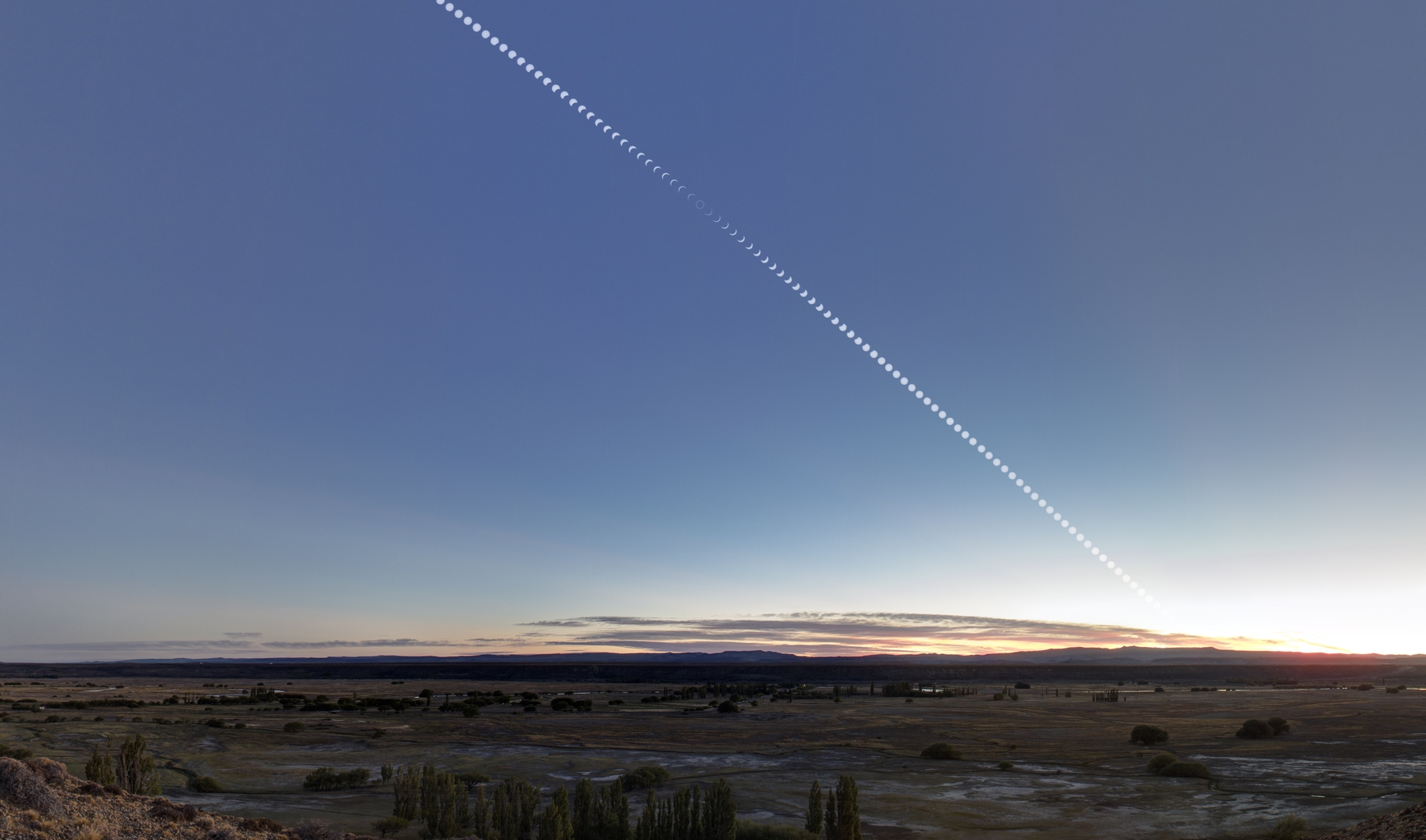
Annular Eclipse After Sunrise
Image Credit & Copyright: Vincent Bouchama
Explanation: From northern Patagonia, morning skies were clear and blue on Sunday, February 26. This sweeping composite scene, overlooking Hermoso Valle, Facundo, Chubut, Argentina, follows the Sun after sunrise, capturing an annular solar eclipse. Created from a series of exposures at three minute intervals, it shows the year's first solar eclipse beginning well above the distant eastern horizon. An exposure close to mid-eclipse recorded the expected ring of fire, the silhouette of the New Moon only slightly too small to cover the bright Sun. At that location on planet Earth, the annular phase of the eclipse lasted a brief 45 seconds.

Annular Eclipse After Sunrise
Image Credit & Copyright: Vincent Bouchama
Explanation: From northern Patagonia, morning skies were clear and blue on Sunday, February 26. This sweeping composite scene, overlooking Hermoso Valle, Facundo, Chubut, Argentina, follows the Sun after sunrise, capturing an annular solar eclipse. Created from a series of exposures at three minute intervals, it shows the year's first solar eclipse beginning well above the distant eastern horizon. An exposure close to mid-eclipse recorded the expected ring of fire, the silhouette of the New Moon only slightly too small to cover the bright Sun. At that location on planet Earth, the annular phase of the eclipse lasted a brief 45 seconds.

panosol- Αριθμός μηνυμάτων : 762
Points : 927
Reputation : 15
Ημερομηνία εγγραφής : 17/06/2012
Ηλικία : 56
Σελίδα 3 από 15 •  1, 2, 3, 4 ... 9 ... 15
1, 2, 3, 4 ... 9 ... 15 
Σελίδα 3 από 15
Δικαιώματα σας στην κατηγορία αυτή
Δεν μπορείτε να απαντήσετε στα Θέματα αυτής της Δ.Συζήτησης|
|
|

 Αρχική
Αρχική Φόρουμ
Φόρουμ RADIO
RADIO ΠΑΙΓΝΙΔΙΑ
ΠΑΙΓΝΙΔΙΑ Latest images
Latest images Εγγραφή
Εγγραφή Σύνδεση
Σύνδεση




» ΚΑΛΗ ΑΝΑΣΤΑΣΗ ΚΑΙ ΚΑΛΟ ΠΑΣΧΑ!!
» Εφυγε από τη ζωή ο Τζίμης Πανούσης
» ΧΡΟΝΙΑ ΠΟΛΛΑ ΚΑΙ ΚΑΛΗ ΧΡΟΝΙΑ ΜΕ ΥΓΕΙΑ ΚΑΙ ΕΥΤΥΧΙΑ!!!
» This day in music
» Astronomy Picture of the Day
» Τις καλύτερες ευχές μου για Ευτυχισμένα Χριστούγεννα σε όλους!!
» ΖΗΤΩ Η 28η ΟΚΤΩΒΡΙΟΥ 1940
» ΖΗΤΩ Η 28η ΟΚΤΩΒΡΙΟΥ 1940
» Το τελευταίο αντίο στη Ζωή Λάσκαρη
» 19 Μαΐου: Ημέρα Μνήμης της Γενοκτονίας των Ποντίων
» Kαλό σου ταξίδι!!
» ΧΡΙΣΤΟΣ ΑΝΕΣΤΗ!!
» ΚΑΛΗ ΜΕΓΑΛΗ ΕΒΔΟΜΑΔΑ!!
» ΚΑΛΟ ΜΗΝΑ!!!
» ΧΡΟΝΙΑ ΠΟΛΛΑ!!
» ΧΡΟΝΙΑ ΠΟΛΛΑ!!
» R.I.P. Chuck Berry
» 8 Μαρτίου - Παγκόσμια Ημέρα της Γυναίκας
» ΧΡΟΝΙΑ ΠΟΛΛΑ ΚΑΙ ΚΑΛΗ ΣΑΡΑΚΟΣΤΗ!!